Topic 2 - Question Set 2
Question:46
A company is developing a Java web app. The web app code is hosted in a GitHub repository located at https://github.com/Contoso/webapp.
The web app must be evaluated before it is moved to production. You must deploy the initial code release to a deployment slot named staging.
You need to create the web app and deploy the code.
How should you complete the commands? To answer, select the appropriate options in the answer area.
NOTE: Each correct selection is worth one point.
Hot Area:
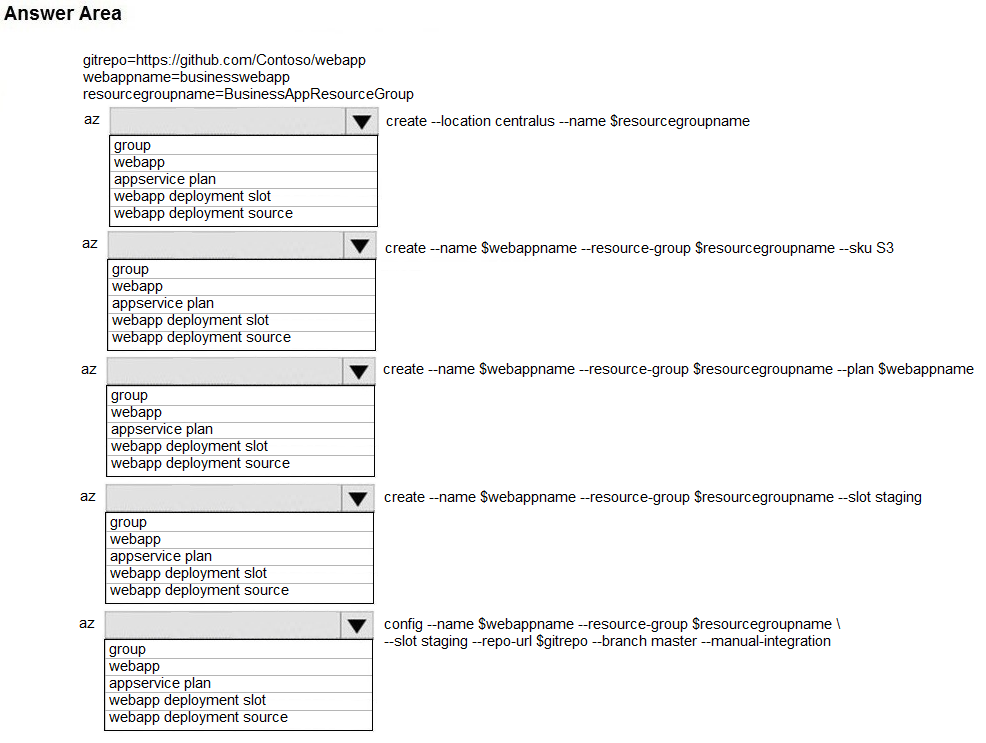
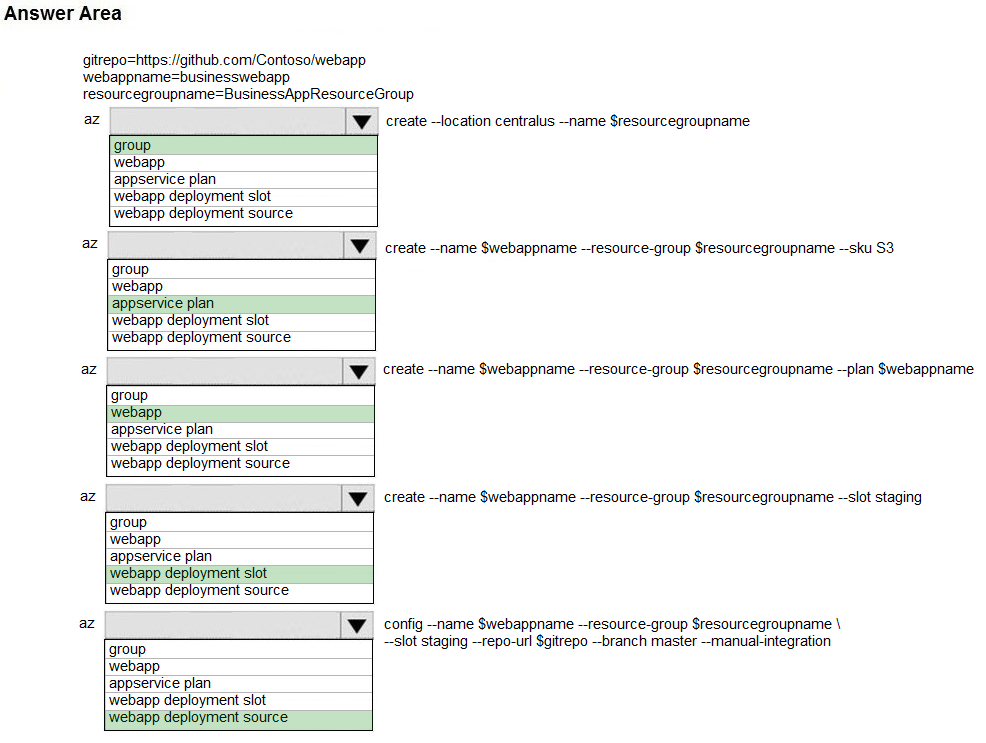
Box 1: group -
# Create a resource group.
az group create --location westeurope --name myResourceGroup
Box 2: appservice plan -
# Create an App Service plan in STANDARD tier (minimum required by deployment slots). az appservice plan create --name $webappname --resource-group myResourceGroup --sku S1
Box 3: webapp -
# Create a web app.
az webapp create --name $webappname --resource-group myResourceGroup \
--plan $webappname
Box 4: webapp deployment slot -
#Create a deployment slot with the name "staging".
az webapp deployment slot create --name $webappname --resource-group myResourceGroup \
--slot staging
Box 5: webapp deployment source -
# Deploy sample code to "staging" slot from GitHub.
az webapp deployment source config --name $webappname --resource-group myResourceGroup \
--slot staging --repo-url $gitrepo --branch master --manual-integration
Reference:
https://docs.microsoft.com/en-us/azure/app-service/scripts/cli-deploy-staging-environment
Question:47
You have a web service that is used to pay for food deliveries. The web service uses Azure Cosmos DB as the data store.
You plan to add a new feature that allows users to set a tip amount. The new feature requires that a property named tip on the document in Cosmos DB must be present and contain a numeric value.
There are many existing websites and mobile apps that use the web service that will not be updated to set the tip property for some time.
How should you complete the trigger?
NOTE: Each correct selection is worth one point.
Hot Area:
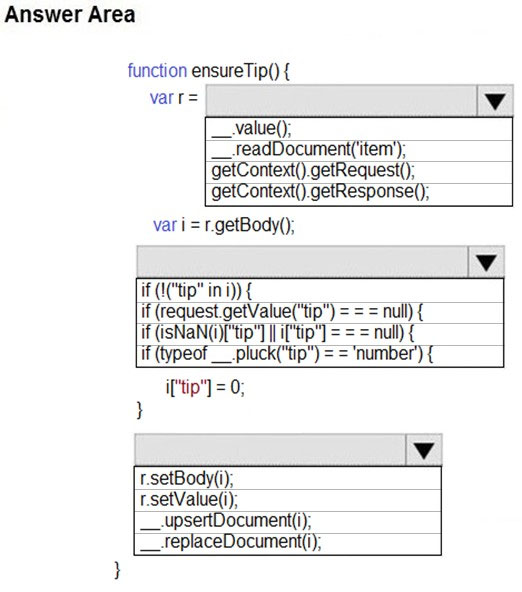
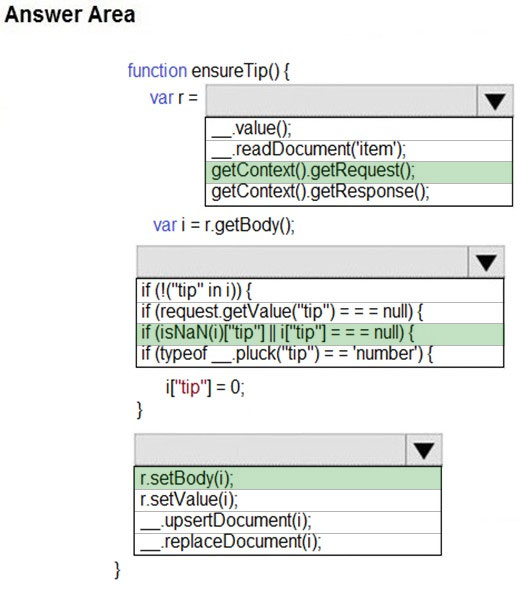
Question:48
Note: This question is part of a series of questions that present the same scenario. Each question in the series contains a unique solution that might meet the stated goals. Some question sets might have more than one correct solution, while others might not have a correct solution.
After you answer a question in this section, you will NOT be able to return to it. As a result, these questions will not appear in the review screen.
You develop an HTTP triggered Azure Function app to process Azure Storage blob data. The app is triggered using an output binding on the blob.
The app continues to time out after four minutes. The app must process the blob data.
You need to ensure the app does not time out and processes the blob data.
Solution: Use the Durable Function async pattern to process the blob data.
Does the solution meet the goal?
- A. Yes
- B. No
Note: Large, long-running functions can cause unexpected timeout issues. General best practices include:
Whenever possible, refactor large functions into smaller function sets that work together and return responses fast. For example, a webhook or HTTP trigger function might require an acknowledgment response within a certain time limit; it's common for webhooks to require an immediate response. You can pass the
HTTP trigger payload into a queue to be processed by a queue trigger function. This approach lets you defer the actual work and return an immediate response.
Reference:
https://docs.microsoft.com/en-us/azure/azure-functions/functions-best-practices
Question:49
Note: This question is part of a series of questions that present the same scenario. Each question in the series contains a unique solution that might meet the stated goals. Some question sets might have more than one correct solution, while others might not have a correct solution.
After you answer a question in this section, you will NOT be able to return to it. As a result, these questions will not appear in the review screen.
You develop an HTTP triggered Azure Function app to process Azure Storage blob data. The app is triggered using an output binding on the blob.
The app continues to time out after four minutes. The app must process the blob data.
You need to ensure the app does not time out and processes the blob data.
Solution: Pass the HTTP trigger payload into an Azure Service Bus queue to be processed by a queue trigger function and return an immediate HTTP success response.
Does the solution meet the goal?
- A. Yes
- B. No
Whenever possible, refactor large functions into smaller function sets that work together and return responses fast. For example, a webhook or HTTP trigger function might require an acknowledgment response within a certain time limit; it's common for webhooks to require an immediate response. You can pass the
HTTP trigger payload into a queue to be processed by a queue trigger function. This approach lets you defer the actual work and return an immediate response.
Reference:
https://docs.microsoft.com/en-us/azure/azure-functions/functions-best-practices
Question:50
Note: This question is part of a series of questions that present the same scenario. Each question in the series contains a unique solution that might meet the stated goals. Some question sets might have more than one correct solution, while others might not have a correct solution.
After you answer a question in this section, you will NOT be able to return to it. As a result, these questions will not appear in the review screen.
You develop an HTTP triggered Azure Function app to process Azure Storage blob data. The app is triggered using an output binding on the blob.
The app continues to time out after four minutes. The app must process the blob data.
You need to ensure the app does not time out and processes the blob data.
Solution: Configure the app to use an App Service hosting plan and enable the Always On setting.
Does the solution meet the goal?
- A. Yes
- B. No
Note: Large, long-running functions can cause unexpected timeout issues. General best practices include:
Whenever possible, refactor large functions into smaller function sets that work together and return responses fast. For example, a webhook or HTTP trigger function might require an acknowledgment response within a certain time limit; it's common for webhooks to require an immediate response. You can pass the
HTTP trigger payload into a queue to be processed by a queue trigger function. This approach lets you defer the actual work and return an immediate response.
Reference:
https://docs.microsoft.com/en-us/azure/azure-functions/functions-best-practices
Question:51
Note: This question is part of a series of questions that present the same scenario. Each question in the series contains a unique solution that might meet the stated goals. Some question sets might have more than one correct solution, while others might not have a correct solution.
After you answer a question in this section, you will NOT be able to return to it. As a result, these questions will not appear in the review screen.
You develop a software as a service (SaaS) offering to manage photographs. Users upload photos to a web service which then stores the photos in Azure
Storage Blob storage. The storage account type is General-purpose V2.
When photos are uploaded, they must be processed to produce and save a mobile-friendly version of the image. The process to produce a mobile-friendly version of the image must start in less than one minute.
You need to design the process that starts the photo processing.
Solution: Move photo processing to an Azure Function triggered from the blob upload.
Does the solution meet the goal?
- A. Yes
- B. No
Events are pushed using Azure Event Grid to subscribers such as Azure Functions, Azure Logic Apps, or even to your own http listener.
Note: Only storage accounts of kind StorageV2 (general purpose v2) and BlobStorage support event integration. Storage (general purpose v1) does not support integration with Event Grid.
Reference:
https://docs.microsoft.com/en-us/azure/storage/blobs/storage-blob-event-overview
Question:52
You are developing an application that uses Azure Blob storage.
The application must read the transaction logs of all the changes that occur to the blobs and the blob metadata in the storage account for auditing purposes. The changes must be in the order in which they occurred, include only create, update, delete, and copy operations and be retained for compliance reasons.
You need to process the transaction logs asynchronously.
What should you do?
- A. Process all Azure Blob storage events by using Azure Event Grid with a subscriber Azure Function app.
- B. Enable the change feed on the storage account and process all changes for available events.
- C. Process all Azure Storage Analytics logs for successful blob events.
- D. Use the Azure Monitor HTTP Data Collector API and scan the request body for successful blob events.
The purpose of the change feed is to provide transaction logs of all the changes that occur to the blobs and the blob metadata in your storage account. The change feed provides ordered, guaranteed, durable, immutable, read-only log of these changes. Client applications can read these logs at any time, either in streaming or in batch mode. The change feed enables you to build efficient and scalable solutions that process change events that occur in your Blob Storage account at a low cost.
Reference:
https://docs.microsoft.com/en-us/azure/storage/blobs/storage-blob-change-feed
Question:53
You plan to create a Docker image that runs an ASP.NET Core application named ContosoApp. You have a setup script named setupScript.ps1 and a series of application files including ContosoApp.dll.
You need to create a Dockerfile document that meets the following requirements:
✑ Call setupScripts.ps1 when the container is built.
✑ Run ContosoApp.dll when the container starts.
The Dockerfile document must be created in the same folder where ContosoApp.dll and setupScript.ps1 are stored.
Which five commands should you use to develop the solution? To answer, move the appropriate commands from the list of commands to the answer area and arrange them in the correct order.
Select and Place:


Box 1: CMD [..]
Cmd starts a new instance of the command interpreter, Cmd.exe.
Syntax: CMD <string>
Specifies the command you want to carry out.
Box 2: FROM microsoft/aspnetcore-build:latest
Box 3: WORKDIR /apps/ContosoApp -
Bxo 4: COPY ./ .
Box 5: RUN powershell ./setupScript.ps1
Question:54
You are developing an Azure Function App that processes images that are uploaded to an Azure Blob container.
Images must be processed as quickly as possible after they are uploaded, and the solution must minimize latency. You create code to process images when the
Function App is triggered.
You need to configure the Function App.
What should you do?
- A. Use an App Service plan. Configure the Function App to use an Azure Blob Storage input trigger.
- B. Use a Consumption plan. Configure the Function App to use an Azure Blob Storage trigger.
- C. Use a Consumption plan. Configure the Function App to use a Timer trigger.
- D. Use an App Service plan. Configure the Function App to use an Azure Blob Storage trigger.
- E. Use a Consumption plan. Configure the Function App to use an Azure Blob Storage input trigger.
The Consumption plan limits a function app on one virtual machine (VM) to 1.5 GB of memory.
Reference:
https://docs.microsoft.com/en-us/azure/azure-functions/functions-bindings-storage-blob-trigger
Question:55
You are configuring a new development environment for a Java application.
The environment requires a Virtual Machine Scale Set (VMSS), several storage accounts, and networking components.
The VMSS must not be created until the storage accounts have been successfully created and an associated load balancer and virtual network is configured.
How should you complete the Azure Resource Manager template? To answer, select the appropriate options in the answer area.
NOTE: Each correct selection is worth one point.
Hot Area:
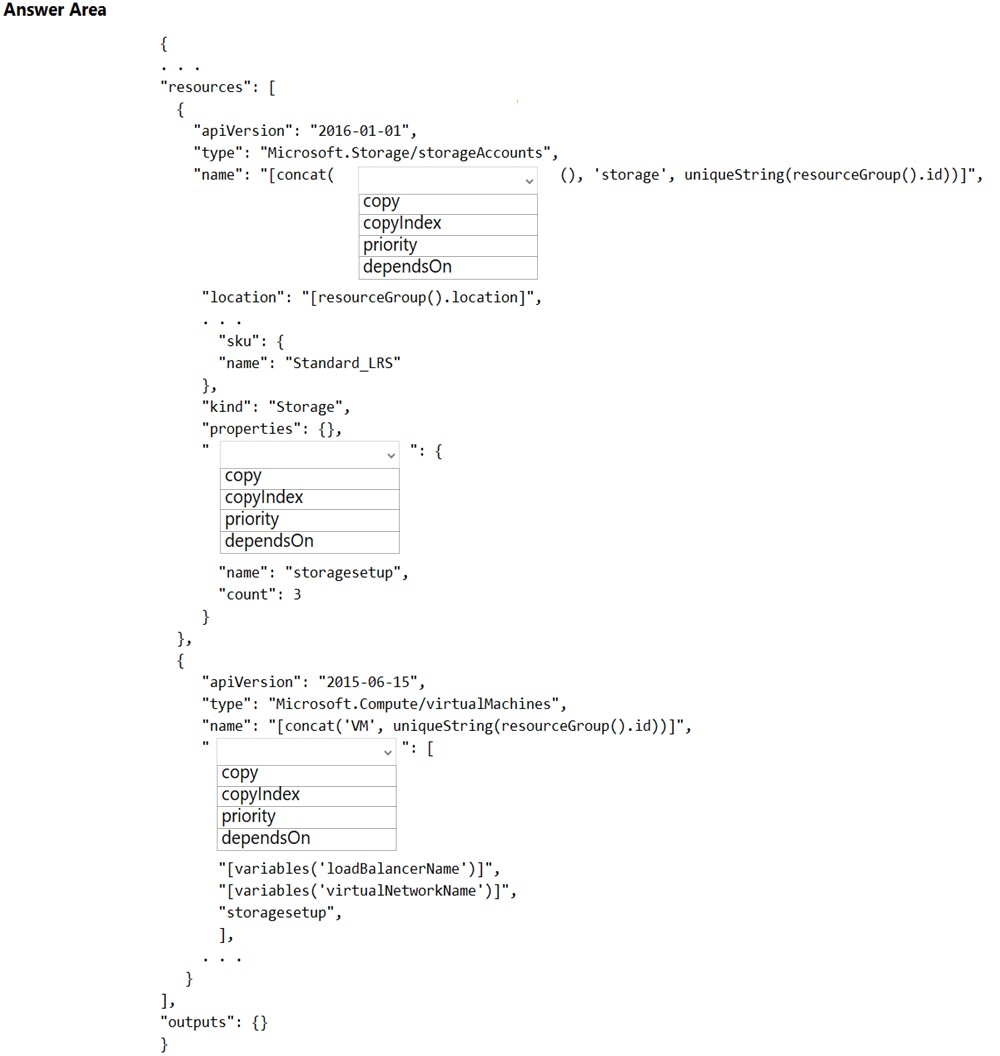
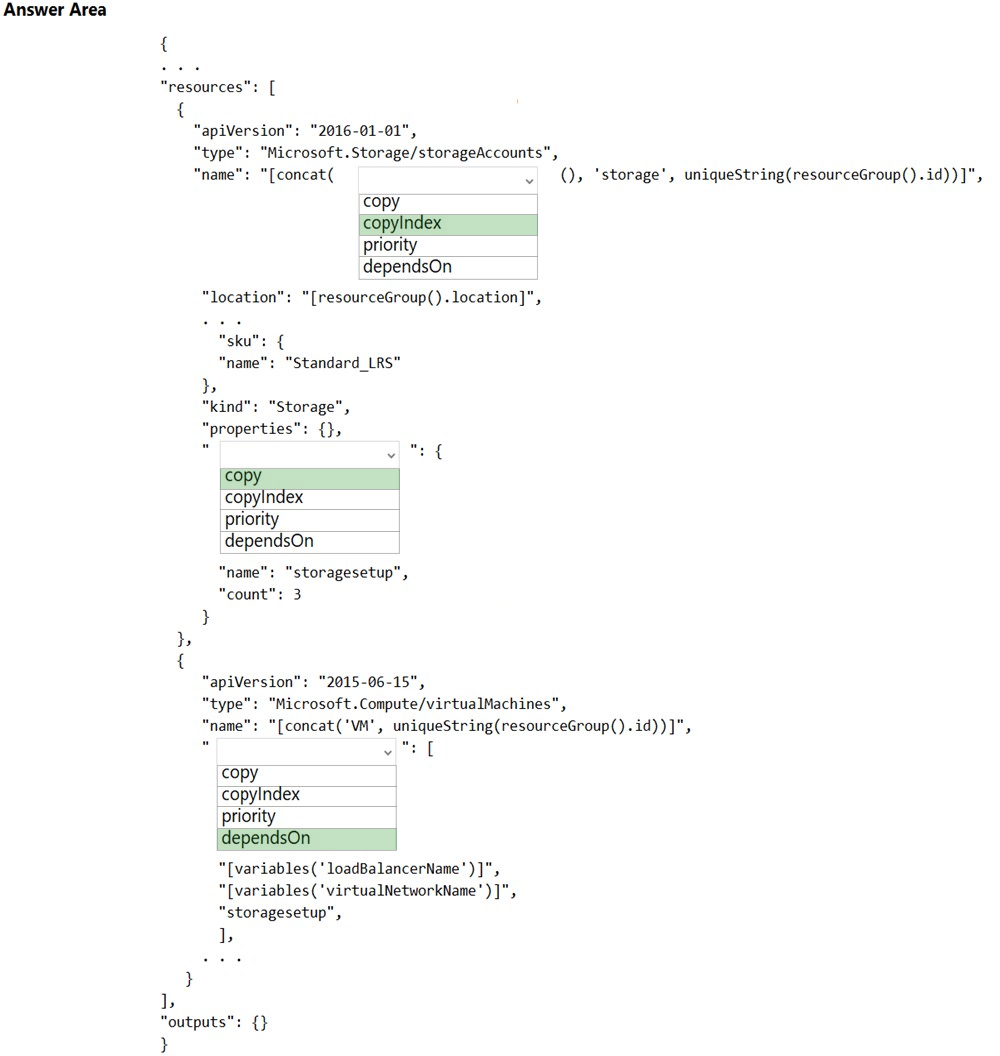
Box 1: copyIndex -
Notice that the name of each resource includes the copyIndex() function, which returns the current iteration in the loop. copyIndex() is zero-based.
Box 2: copy -
By adding the copy element to the resources section of your template, you can dynamically set the number of resources to deploy.
Box 3: dependsOn -
Example:
"type": "Microsoft.Compute/virtualMachineScaleSets",
"apiVersion": "2020-06-01",
"name": "[variables('namingInfix')]",
"location": "[parameters('location')]",
"sku": {
"name": "[parameters('vmSku')]",
"tier": "Standard",
"capacity": "[parameters('instanceCount')]"
},
"dependsOn": [
"[resourceId('Microsoft.Network/loadBalancers', variables('loadBalancerName'))]",
"[resourceId('Microsoft.Network/virtualNetworks', variables('virtualNetworkName'))]"
],
Reference:
https://docs.microsoft.com/en-us/azure/azure-resource-manager/templates/copy-resources https://docs.microsoft.com/en-us/azure/virtual-machine-scale-sets/quick-create-template-windows
Question:56
HOTSPOT -
You are developing an Azure Function App by using Visual Studio. The app will process orders input by an Azure Web App. The web app places the order information into Azure Queue Storage.
You need to review the Azure Function App code shown below.
NOTE: Each correct selection is worth one point.
Hot Area: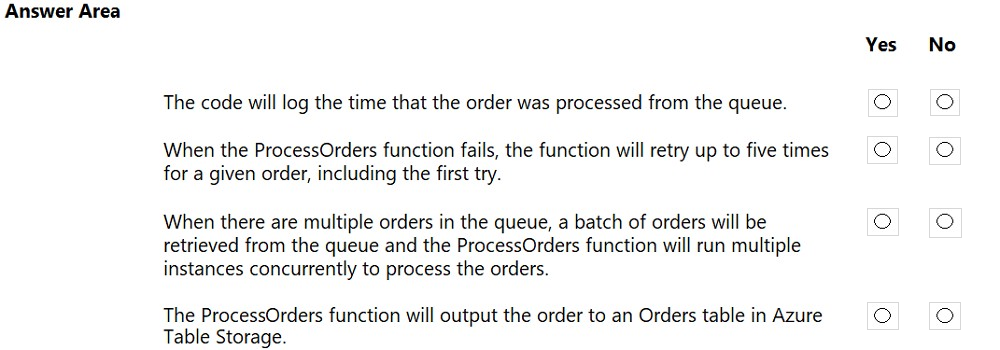
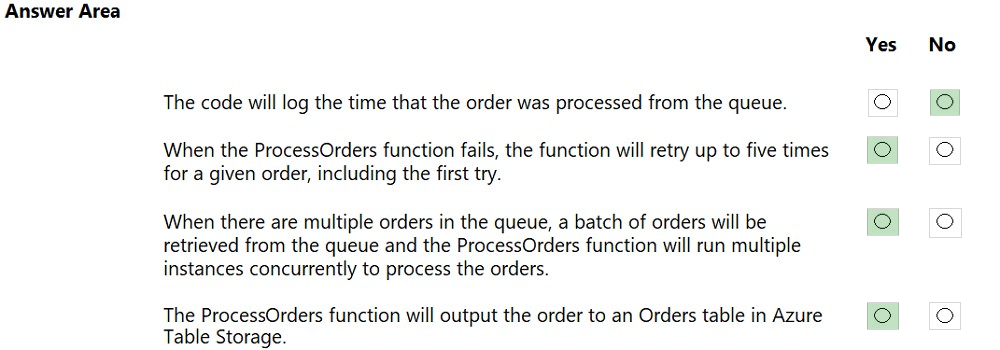
Box 1: No -
ExpirationTime - The time that the message expires.
InsertionTime - The time that the message was added to the queue.
Box 2: Yes -
maxDequeueCount - The number of times to try processing a message before moving it to the poison queue. Default value is 5.
Box 3: Yes -
When there are multiple queue messages waiting, the queue trigger retrieves a batch of messages and invokes function instances concurrently to process them.
By default, the batch size is 16. When the number being processed gets down to 8, the runtime gets another batch and starts processing those messages. So the maximum number of concurrent messages being processed per function on one virtual machine (VM) is 24.
Box 4: Yes -
Reference:
https://docs.microsoft.com/en-us/azure/azure-functions/functions-bindings-storage-queue
Question:57
DRAG DROP -
You are developing a solution for a hospital to support the following use cases:
✑ The most recent patient status details must be retrieved even if multiple users in different locations have updated the patient record.
✑ Patient health monitoring data retrieved must be the current version or the prior version.
✑ After a patient is discharged and all charges have been assessed, the patient billing record contains the final charges.
You provision a Cosmos DB NoSQL database and set the default consistency level for the database account to Strong. You set the value for Indexing Mode to
Consistent.
You need to minimize latency and any impact to the availability of the solution. You must override the default consistency level at the query level to meet the required consistency guarantees for the scenarios.
Which consistency levels should you implement? To answer, drag the appropriate consistency levels to the correct requirements. Each consistency level may be used once, more than once, or not at all. You may need to drag the split bar between panes or scroll to view content.
NOTE: Each correct selection is worth one point.
Select and Place:

Box 1: Strong -
Strong: Strong consistency offers a linearizability guarantee. The reads are guaranteed to return the most recent committed version of an item. A client never sees an uncommitted or partial write. Users are always guaranteed to read the latest committed write.
Box 2: Bounded staleness -
Bounded staleness: The reads are guaranteed to honor the consistent-prefix guarantee. The reads might lag behind writes by at most "K" versions (that is
"updates") of an item or by "t" time interval. When you choose bounded staleness, the "staleness" can be configured in two ways:
The number of versions (K) of the item
The time interval (t) by which the reads might lag behind the writes
Box 3: Eventual -
Eventual: There's no ordering guarantee for reads. In the absence of any further writes, the replicas eventually converge.
Incorrect Answers:
Consistent prefix: Updates that are returned contain some prefix of all the updates, with no gaps. Consistent prefix guarantees that reads never see out-of-order writes.
Reference:
https://docs.microsoft.com/en-us/azure/cosmos-db/consistency-levels
Question:58
You are configuring a development environment for your team. You deploy the latest Visual Studio image from the Azure Marketplace to your Azure subscription.
The development environment requires several software development kits (SDKs) and third-party components to support application development across the organization. You install and customize the deployed virtual machine (VM) for your development team. The customized VM must be saved to allow provisioning of a new team member development environment.
You need to save the customized VM for future provisioning.
Which tools or services should you use? To answer, select the appropriate options in the answer area.
NOTE: Each correct selection is worth one point.
Hot Area:
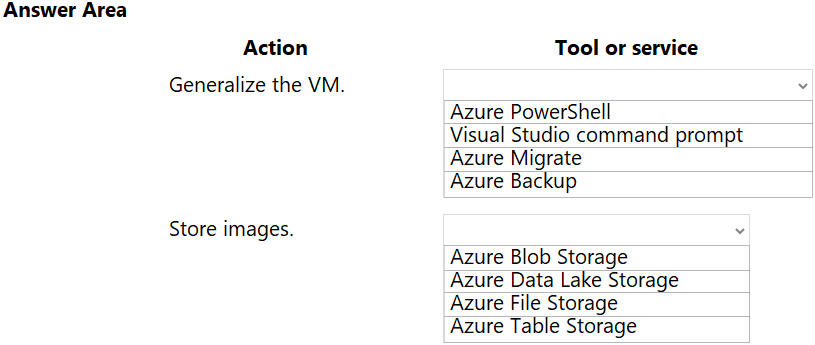
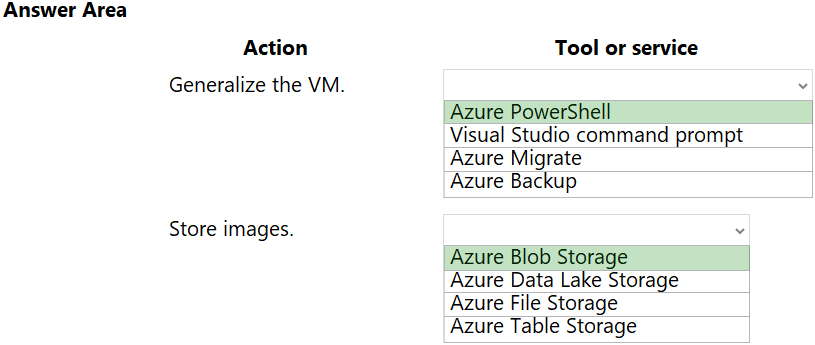
Box 1: Azure Powershell -
Creating an image directly from the VM ensures that the image includes all of the disks associated with the VM, including the OS disk and any data disks.
Before you begin, make sure that you have the latest version of the Azure PowerShell module.
You use Sysprep to generalize the virtual machine, then use Azure PowerShell to create the image.
Box 2: Azure Blob Storage -
You can store images in Azure Blob Storage.
Reference:
https://docs.microsoft.com/en-us/azure/virtual-machines/windows/capture-image-resource#create-an-image-of-a-vm-using-powershell
Question:59
You are preparing to deploy a website to an Azure Web App from a GitHub repository. The website includes static content generated by a script.
You plan to use the Azure Web App continuous deployment feature.
You need to run the static generation script before the website starts serving traffic.
What are two possible ways to achieve this goal? Each correct answer presents a complete solution.
NOTE: Each correct selection is worth one point.
- A. Add the path to the static content generation tool to WEBSITE_RUN_FROM_PACKAGE setting in the host.json file.
- B. Add a PreBuild target in the websites csproj project file that runs the static content generation script.
- C. Create a file named run.cmd in the folder /run that calls a script which generates the static content and deploys the website.
- D. Create a file named .deployment in the root of the repository that calls a script which generates the static content and deploys the website.
\wwwroot directory of your function app (see A above).
To enable your function app to run from a package, you just add a WEBSITE_RUN_FROM_PACKAGE setting to your function app settings.
Note: The host.json metadata file contains global configuration options that affect all functions for a function app.
D: To customize your deployment, include a .deployment file in the repository root.
You just need to add a file to the root of your repository with the name .deployment and the content:
[config]
command = YOUR COMMAND TO RUN FOR DEPLOYMENT
this command can be just running a script (batch file) that has all that is required for your deployment, like copying files from the repository to the web root directory for example.
Reference:
https://github.com/projectkudu/kudu/wiki/Custom-Deployment-Script https://docs.microsoft.com/bs-latn-ba/azure/azure-functions/run-functions-from-deployment-package
Question:60
You are developing an application to use Azure Blob storage. You have configured Azure Blob storage to include change feeds.
A copy of your storage account must be created in another region. Data must be copied from the current storage account to the new storage account directly between the storage servers.
You need to create a copy of the storage account in another region and copy the data.
In which order should you perform the actions? To answer, move all actions from the list of actions to the answer area and arrange them in the correct order.
Select and Place:
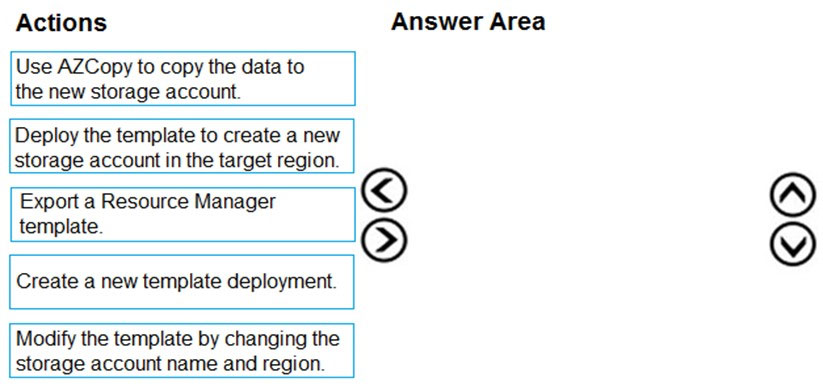
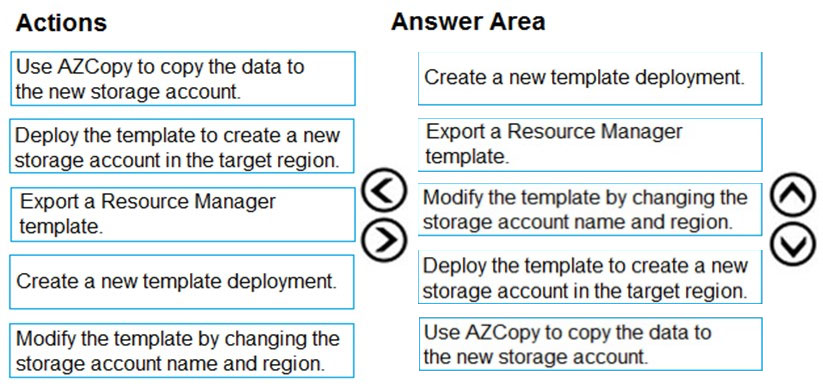
To move a storage account, create a copy of your storage account in another region. Then, move your data to that account by using AzCopy, or another tool of your choice.
The steps are:
✑ Export a template.
✑ Modify the template by adding the target region and storage account name.
✑ Deploy the template to create the new storage account.
✑ Configure the new storage account.
✑ Move data to the new storage account.
✑ Delete the resources in the source region.
Note: You must enable the change feed on your storage account to begin capturing and recording changes. You can enable and disable changes by using Azure
Resource Manager templates on Portal or Powershell.
Reference:
https://docs.microsoft.com/en-us/azure/storage/common/storage-account-move https://docs.microsoft.com/en-us/azure/storage/blobs/storage-blob-change-feed

